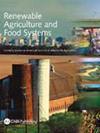东京都分配花园供应的地理空间特征
IF 2
3区 农林科学
Q2 AGRICULTURE, MULTIDISCIPLINARY
引用次数: 0
摘要
摘要分配花园(AGs)是城市农业(UA)最流行的形式之一,因其为市民提供的生态系统服务而引起了社会的关注。然而,由于地理位置的原因,AGs的服务和可用性可能分布不均匀。东京向用户提供AG地块和设施的模式尚不清楚。因此,本研究定量地考察了东京大都市区不同类型农业供应的特征及其决定因素。通过对政府公开数据中收集的313个农用地提供模式的非分层聚类分析,我们根据农用地的性质,包括地块数量、地块大小、合同价格和期限,以及农用设备和教师等设施,对农用地提供模式进行了分类。此外,我们使用Kruskal-Wallis检验了城市发展和居住特征对这些类别的影响。该分析根据其属性确定了六种AG供应模式。该研究还发现,东京的农业用地比例和居民的社会人口特征(包括人口、年轻人口比例和从市中心到郊区的收入水平)与城市扩张相对应,从而区分了农业用地的供应。这些发现可以提供有价值的见解,帮助地方政府、农民和非营利组织应对各种农业供应模式带来的挑战和机遇,并使农业用地和设施更适应即将到来的城市萎缩、商业机会、可能的过度细分和价格上涨。本文章由计算机程序翻译,如有差异,请以英文原文为准。
Geospatial characteristics of allotment garden provision in Tokyo
Abstract Allotment gardens (AGs), one of the most popular forms of urban agriculture (UA), have attracted social attention because of the ecosystem services they provide to citizens. However, the services and availability of AGs may be unevenly distributed, owing to their geographic location. The patterns underlying the provision of AG plots and facilities to users in Tokyo are unclear. Thus, this study quantitatively examines the characteristics of different types of AG provision and their determinants in the metropolitan region of Tokyo. We classified a sample of 313 AGs gathered from governmental open data via a non-hierarchical cluster analysis of AG provision patterns based on their properties, including number of plots, plot size, contract price and duration, and facilities such as agricultural equipment and access to instructors. Moreover, we examined the influence of urban development and residential characteristics on these classes using the Kruskal–Wallis test. The analysis identifies six AG provision patterns based on their properties. It also revealed that AG provision in Tokyo was differentiated by the percentage of agricultural land and the socio-demographic characteristics of residents, including population, percentage of young population, and income levels from the city center to the suburban areas, corresponding to urban sprawl. These findings could provide valuable insights to help local governments, farmers, and non-profit organizations address the challenges and opportunities arising from each AG provision pattern and to make AG plots and facilities more adaptable to upcoming urban shrinkage, business opportunities, and possible excessive subdivision and price hikes.
求助全文
通过发布文献求助,成功后即可免费获取论文全文。
去求助
来源期刊

Renewable Agriculture and Food Systems
农林科学-农业综合
CiteScore
5.20
自引率
7.40%
发文量
39
审稿时长
>36 weeks
期刊介绍:
Renewable Agriculture and Food Systems (formerly American Journal of Alternative Agriculture) is a multi-disciplinary journal which focuses on the science that underpins economically, environmentally, and socially sustainable approaches to agriculture and food production. The journal publishes original research and review articles on the economic, ecological, and environmental impacts of agriculture; the effective use of renewable resources and biodiversity in agro-ecosystems; and the technological and sociological implications of sustainable food systems. It also contains a discussion forum, which presents lively discussions on new and provocative topics.
 求助内容:
求助内容: 应助结果提醒方式:
应助结果提醒方式:


